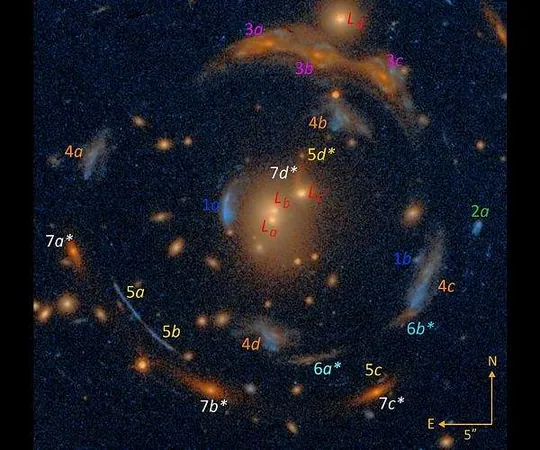
Revolutionizing Our Understanding of the Universe: The Future of Multi-Messenger Gravitational Lensing
2025-06-16
Author: Li
A Groundbreaking Approach to Cosmic Exploration
In an astonishing breakthrough, a team of international scientists led by the University of Birmingham has unveiled a revolutionary method poised to reshape our understanding of the cosmos. By integrating gravitational lensing with cutting-edge instruments that detect gravitational waves and electromagnetic signals, this innovative approach, termed multi-messenger gravitational lensing, could transform the fields of cosmology and astrophysics.
The Power of Gravity and Light
Using the immense gravitational forces of galaxies and galaxy clusters, this method allows researchers to bend and magnify distant astronomical events like never before. When paired with advanced detectors capturing a broad spectrum of signals—from gravitational waves to gamma rays—scientists are positioned to deepen their insights into the universe's structure and origins.
Tackling the Challenges Ahead
However, this path is not without its hurdles. The researchers, publishing their findings in The Philosophical Transactions of The Royal Society A, acknowledge significant challenges, including accurately locating lensed explosions and fostering interdisciplinary collaboration. They emphasize the necessity for improved cooperation, enhanced data sharing, and innovative analytical techniques to conquer these obstacles.
A New Era of Discovery on the Horizon
Professor Graham Smith states, "With recent advancements in detector technology, we're now capable of observing cosmic events across an immense range of energies—from radio waves to gravitational waves. This pioneering approach is set to yield major scientific advancements in the next 5-10 years, helping us tackle profound questions about gravity, the universe's expansion, dark matter, and the formation of stellar compact objects like black holes and neutron stars."
Upcoming Groundbreaking Observatories
Excitingly, upcoming observatories such as the Vera C. Rubin Observatory and LIGO-Virgo-KAGRA are expected to play pivotal roles in this groundbreaking research. The Vera C. Rubin Observatory's Legacy Survey of Space and Time (LSST), launching in late 2025, is anticipated to revolutionize the field of multi-messenger astrophysics. A sneak peek at its initial sky survey results is scheduled for this summer.
Collaboration: The Key to Innovation
The collaborative nature of this breakthrough science is underscored by Professor Smith: "The journey to this point has been a concerted effort by a global community, including many early-career researchers, paving the way for thrilling future opportunities. By uniting our talents, we can ignite innovations and discoveries that will redefine our understanding of the universe."
Emerging Enthusiasm Among Researchers
Dr. Gavin Lamb from Liverpool John Moores University adds, "This ambitious vision for future science will unfold as our detectors grow more sensitive. What seemed like a novel idea just a decade ago is now becoming the foundation for the next generation of scientists." Helena Ubach, a postgraduate researcher from Universitat de Barcelona, shares this enthusiasm, stating, "I am thrilled to be part of this endeavor and eagerly anticipate the advancements in the burgeoning field of Multi-Messenger Gravitational Lensing."
The Future Beckons
With a surge of excitement and collaboration at the forefront, the scientific community is ready to unlock the universe's secrets through multi-messenger gravitational lensing, ushering in a new era of astronomical discovery.


 Brasil (PT)
Brasil (PT)
 Canada (EN)
Canada (EN)
 Chile (ES)
Chile (ES)
 Česko (CS)
Česko (CS)
 대한민국 (KO)
대한민국 (KO)
 España (ES)
España (ES)
 France (FR)
France (FR)
 Hong Kong (EN)
Hong Kong (EN)
 Italia (IT)
Italia (IT)
 日本 (JA)
日本 (JA)
 Magyarország (HU)
Magyarország (HU)
 Norge (NO)
Norge (NO)
 Polska (PL)
Polska (PL)
 Schweiz (DE)
Schweiz (DE)
 Singapore (EN)
Singapore (EN)
 Sverige (SV)
Sverige (SV)
 Suomi (FI)
Suomi (FI)
 Türkiye (TR)
Türkiye (TR)
 الإمارات العربية المتحدة (AR)
الإمارات العربية المتحدة (AR)